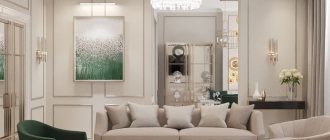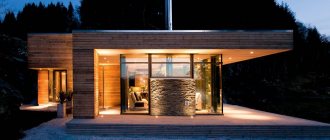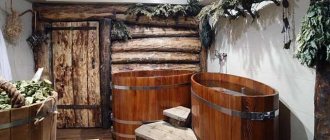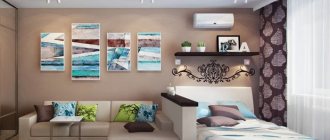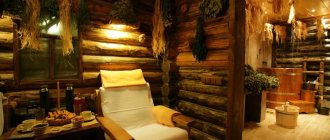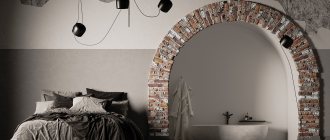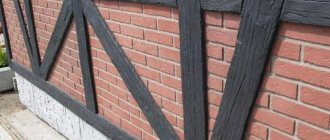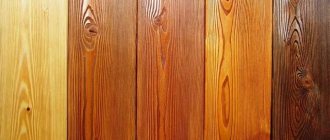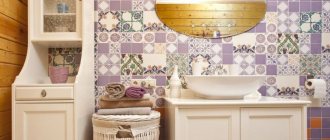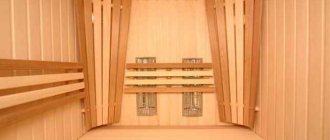An individual design for a chalet-style bathhouse is not just construction documentation, it is a whole work of art. To create it, it is not enough to estimate the dimensions and technical characteristics of the future structure and find an intelligent specialist. To get a real chalet-style bathhouse, you need to be imbued with the spirit of ancient Alpine hospitality, good quality and thoroughness. Anyone who is simply chasing fashion and wants to show off to their friends by following a popular style is unlikely to be able to achieve success in this style.
A chalet is not just an architectural style, it is a special state of mind. Perhaps this is why it is better to design a bathhouse in it, rather than a country house. After all, the bathhouse is traditionally perceived as a place of rest and relaxation of soul and body, and therefore the style of a classic alpine house, where everyone will feel protected from troubles and bad weather, is perfect for it.
A chalet-style log bathhouse with a large panoramic window is an excellent solution for decorating a suburban area.
A small-sized bathhouse from a log house, as an example of proper project planning.
For an elegant chalet-style bathhouse, the lighting was chosen correctly.
Roof
An Alpine house, as a rule, is striking for its original roof design: most often it is gable and very sloping.
The roof should protrude far beyond the wall (at least three to four meters). By the way, it is this tradition in the construction of houses in the Alps that makes the houses so beautiful on the magically quiet pre-Christmas winter evenings.
To prevent roofs from collapsing under the weight of a huge amount of snow, special beams are installed along its perimeter; they not only play a decorative role (as many people think), but also serve as supports, holding the roof in its natural position.
An alpine house usually has many windows, and they are quite large. This tradition has already developed as a result of the work of modern designers. Agree, it’s very nice to have breakfast in the lap of nature, with the windows open.
In rainy and gloomy weather, you can always sit there on a cozy evening with friends and family over a delicious barbecue. The terrace is supported by massive columns, beautiful wicker furniture is placed on it, and containers with fresh flowers are placed along the perimeter.
Similarities
The sauna from Finland and the bathhouse from Russia are useful places that provide pleasant steam treatments. Moist or dry air contributes to:
- Complete relaxation of the body. Muscles are relieved of tension.
- Relief from fatigue and stress. Good spirits and vitality return.
- Steaming the skin. The pores open, allowing toxins and impurities to come out.
- Accelerates blood microcirculation. The replenishment of organs and individual parts of the body is more intense.
- Removing excess fluid from the body. Steam rooms are recommended for girls who want to lose weight.
- Skin rejuvenation. The epithelium tightens, becomes more elastic, elastic. After several regular sessions, the “orange peel” appearance decreases.
- Hardening the body.
- Strengthening the immune system.
Steam rooms from Finland and Russia cannot be equated. There are certainly many similarities between them, but there are also plenty of differences. Where to go to relax, everyone should decide for themselves
It is important that visiting the steam room is a pleasure, not a discomfort.
Types and designs of tandoors
Recent posts Chainsaw or electric saw - what to choose for the garden? 4 mistakes when growing tomatoes in pots that almost all housewives make Secrets of growing seedlings from the Japanese, who are very sensitive to the soil
- stationary ovens;
- ovens with portable (mobile) placement.
Stationary ovens have larger dimensions, are shaped like a hemisphere, and their diameter is within one meter. Made from ceramic bricks and clay. Such tandoors are most often built with their own hands. They can be either horizontal or vertical axis. The former are intended only for baking bread, and the latter for absolutely any dish, in particular shish kebab, samosa, bread flatbread, fish, vegetables, etc. The cooked food is removed using long hooks or ladles with a handle. The main advantage of such tandoors in comparison with the same brick barbecue is not only the taste of the dishes, but also the saving of firewood for heating by 2-3 times.
Mobile tandoors are a modern interpretation of the first ovens of this kind, which are sold ready-made. They are made of fireclay clay with a wall thickness of 3 to 7 cm. They are much smaller in size compared to stationary structures. To improve the properties, an additional outer layer of thermal insulation material is applied. They are decorated in an interesting design with common characteristic features, namely the presence of forged elements in the form of handles and rims. Outwardly, they quite closely resemble a vase or urn. A more modern design allows you to install the skewers in a vertical position, as well as insert a grid, which is usually included with the oven. Below there is a blower with a metal lid.
electric tandoors dry out the air
But it should be noted that there are high-tech electric tandoors, the cost of which is unlikely to attract the average resident of our country. Such equipment is equipped with an on-board computer, additional thermal insulation of clay material, a special nano-device that portionwise humidifies the air in the chamber and other results of scientific and technological progress.
Features of bathhouse projects
The Alpine-style bathhouse project involves the use of natural materials: stone and wood. In the modern version, it is allowed to sheathe the first floor of the bathhouse with brick or foam concrete.
Doors should be made large and glass. There should also be a lot of windows. The roof is usually made of two or four slopes.
When choosing materials, it is worth considering that the roof must be durable and frost-resistant, retain heat and have good sound insulation. The covering is usually wooden shingles, but other variations are possible.
The architectural style of the chalet is easily recognizable, as it has a number of distinctive features:
- One of the main features of the chalet is the sloping roof with large overhangs - the edge of the roof protrudes significantly beyond the edge of the facade. This type of roof has several advantages. Firstly, the aesthetic appearance. The bathhouse looks like a real home. Secondly, functional significance. Such a roof protects the façade of the building from bad weather. And in winter it holds a large amount of snow.
- Another distinctive feature is the high stone base. It makes the building durable and protects from harsh weather conditions. For the construction of the first floor, materials such as facing stone, brick and textured plaster are usually used.
- The attic is built from wood, timber or softwood logs. This ensures lightness of the upper structure. The chalet style is characterized by simplicity of execution. Therefore, there are no complex wooden patterns here.
- Another characteristic feature of the chalet are the spacious balconies and terraces. As a rule, they are located under the roof. This allows you to be outside even in bad weather. As a finishing material, a special decking board is usually used, which is resistant to moisture and temperature changes. This helps make the terrace beautiful, warm and cozy.
Chalet style surface finishes and colors
The use of natural materials in home decoration is the main feature of this design. Forget about gypsum board, ceramic tiles, textile wallpaper. The chalet style is based on clear harmony and interaction of clay, wood and stone. As you can see, these are exclusively environmentally friendly materials without synthetic additives. The floor, as a rule, is a massive unpainted board covered with stain, wax or varnish.
The walls must be either plastered or lined with wood, which is preferable. A popular practice is to cover one wall with horizontal boards. It looks beautiful and can effectively replace boring brick cladding. This solution is applicable both for one room and for the entire apartment as a whole.
Chalet style rooms
Protruding ceiling beams are the hallmark of the chalet. Of course, they cannot be installed in an apartment with a 2.5 meter ceiling, but they are quite appropriate in high rooms. This will not only decorate the ceiling surface, but will also hide all its defects, such as cracks and irregularities. If it is impossible to install beams, we strongly recommend repairing and whitewashing the ceiling.
As a rule, when decorating a chalet-style apartment, natural color shades are used, such as terracotta, beige, cream and dark wood. Accents in the rooms are created by dark colors: burgundy, chocolate and dark green. The chalet style is characterized by shades of red, brown, burgundy, and the color of lush green grass. The main thing is that the primary colors should be natural, close to nature. It is allowed to dilute them with colorful accents
Be careful: this must be done carefully so as not to spoil the atmosphere of the room
Why is the style so popular?
The Chalet style suits hospitable people who:
- value simplicity;
- love stability, romance and tranquility;
- strive to be closer to nature;
- surround themselves with environmentally friendly materials;
- create an atmosphere of continuity.
Interior
The appearance of the chalet style in design is due to ordinary shepherds from the mountain Alps. They built their homes in mountainous conditions, so they made them reliable and warm.
Therefore, in such rooms, preference is given to natural and unprocessed materials, simple and environmentally friendly. It may resemble rural country style, however, there are fundamental differences.
Classic chalet style interior with ceiling beams
For example, although little things play a role in style, it is not so focused on them, we can say that everything in buildings is more concise and practical. For example, solid boards are placed on the floor, which are not painted or varnished.
Wall cladding - plaster or wood. The highlight of any building is the protruding ceiling beams. In addition, the interior must have a large fireplace, as in the English style. This is probably a tribute to those times when shepherds had to hide from bad weather, warming themselves in the evenings.
A fireplace in the room is a must
It is advisable to install furniture that is aged, simple in shape, with untreated wooden facades and surfaces. The decoration of the rest room will be large leather chairs and sofas, giving off a certain simplicity and roughness.
Decor
It can be roughly divided into two options:
- Feminine, where aged ceramic dishes, old paintings in wooden frames and photographs, rustic embroidery and small crafts come first.
Women's decor option
- Men's, which is filled with a hunting theme. Here the instructions are simple: the walls should be decorated with trophies, tapestries with hunting motifs, animal skins and forged items.
Hunting decor
The color scheme in the bath should be mostly natural - dark, beige, cream, terracotta. In textiles and furniture upholstery - the colors of undyed fabrics. They come in rich dark colors - chocolate, dark green, burgundy.
Although the chalet style was originally formed for a country house, it also has a place in other buildings, in particular in a bathhouse. A prerequisite is the height of the ceilings of the bathhouse and sufficient footage.
Massive logs in chalet style
Typically, chalet-style bath projects are small in size. However, in addition to a steam room, a relaxation room and a washing room, it contains a kitchen and even bedrooms. The building turns into a guest house where you can spend the night yourself or provide guests with a bed.
The interior of the chalet has its own characteristics that differ from other room designs. This is expressed in high ceilings and a combination of two natural materials - wood and stone, since it was from them that the first such buildings were built. A special flavor is created by lamps that are styled with your own hands to look like antique lamps. In the rest room, a separate stove is installed with a firebox inside the room.
Distinctive features
Before you begin construction work, you need to understand what features the chalet style has. At first, interiors in this style were chosen only for country houses, but now bathhouses and various other buildings are also decorated in this way. Mandatory conditions are the presence of a large space and fairly high ceilings.
In addition, a bathhouse designed in this way should be:
- flat;
- quite simple;
- squat;
- sustainable.
A building in this style should evoke a feeling of peace and be associated with reliability.
The following important features of this style can be highlighted:
- open terraces;
- sloping roofs with large overhangs;
- The walls are made of solid timber, the base is made of stone.
Baths in this style are suitable for those who:
- prefers to use environmentally friendly materials;
- gravitates towards calm, romance and stability;
- always chooses simplicity;
- prefers to be close to nature.
Chalet interior
The Alpine interior is characterized by simplicity and comfort. The decoration of a chalet-style bathhouse is done using natural, eco-friendly, unprocessed materials. Most often these are stone and wood or materials imitating them.
The stone walls of the first floor are plastered or covered with wood. Sometimes you can find stone trim. This decor is made in rooms with high humidity. And there is also wall painting, carving and varnish decoration.
This technique adds an element of antiquity to the overall interior. Sometimes stone is used as flooring. Materials for such coating are selected with abrasions or chips.
The furniture should be solid and wooden, but at the same time comfortable. It must be antique or artificially aged.
Chalet-style furniture is not characterized by decor and patterns. But sometimes you can find walls and chests of drawers with beautiful carvings. The upholstery of such furniture can be plain, patterned or leather. There is also wicker furniture.
The Alpine style is characterized by the natural colors of natural materials. When decorating a room, preference is given to colors such as orange-yellow, creamy beige or terracotta. But the pastel design is diluted with bright accents. These are mainly shades of red.
It is better to choose textile materials for upholstery and decoration from undyed fabrics in natural colors.
Decor
An integral part of the chalet decor is the fireplace. Stone is usually chosen for its cladding. This detail makes the room cozy, warm and comfortable. It is advisable to make the fireplace real, since an electric one will not be able to create the desired atmosphere.
Other decorative elements include carpets and animal skins. They can be laid on the floor or hung on the wall. Tapestries, antlers, rustic embroidery and antique paintings serve as wall decorations.
The aesthetics of alpine decor allows you to show your imagination and find unexpected solutions. But do not forget that modern art objects do not fit into the chalet style.
The chalet style is deliberate negligence and practicality. Chalet-style baths are interesting and unusual. They combine comfort and reliability. At the same time, such a building does not lose its functional significance.
What textiles should I use?
It is impossible to imagine the decoration of a chalet-style cottage without natural textiles. Cotton, linen, chintz, fur and silk are used to the maximum. Sheepskin is especially welcome. Avoid flashy colors; it is better to emphasize the natural origin of materials by choosing unpainted or light-colored samples.
It is recommended to avoid drawings; it is better to decorate textiles with hand embroidery or use plain samples. It's hard to imagine a more harmonious addition to a chalet-style dining room than a dining table covered with an embroidered tablecloth.
Ottomans in the interior of a chalet
Chalet bathroom
Chalet style dining room
Army cast iron stove POV-57
The cast iron army stove stove POV-57 consumes a small amount of fuel, its consumption is quite economical. With one load of the firebox, the room will be provided with heat for 6–9 hours.
Design of an army cast iron "stove"
As the name of the stove suggests, its body is made of cast iron, a material characterized by good strength. Quite thick walls retain heat well and ensure a long service life of the stove.
To install such a device indoors, the construction of a foundation is not required. The ease of installation is explained by the rather simple design of the unit - a cylinder-shaped body is connected to a low stand. The front part of the stove is equipped with two doors: firewood is placed in the large opening, and soot and ash, which are formed after the combustion of solid fuel, are removed from the smaller opening. The housing cover is equipped with a chimney through which smoke is removed from the firebox to the outside. In addition, a vertically installed pipe provides an additional surface through which heat is radiated into the surrounding space. The air heated by burning fuel can circulate inside the furnace for a long time. The POV-57 potbelly stove has in its design special partitions with slots that hold it before being fed into the chimney.
Characteristics and size
Dimensions (DxWxH): 330x330x525
Brand: Balezensky Foundry and Mechanical Plant
Advantages of the POV-57 military stove
Among the main advantages of the unit, the following qualities should be noted:
The weaknesses of the potbelly stove are manifested in the following points:
- there is no possibility of regulating operating modes and heating temperatures;
- strong heating of the housing increases the risk of fire of flammable objects located close to the stove, as well as burns;
- Forced extinguishing with water is not allowed due to cast iron’s intolerance to sudden temperature changes;
- it is difficult to heat more than 40 m2 with one stove;
- The heated room must be ventilated.
Requirements for installing a potbelly stove
The POV-57 cast iron stove is installed in a specially designated place. The most convenient angle for supplying the maximum amount of heat to the entire room is its corner part.
When installing a military stove, you should maintain a distance of 1 m from the nearest walls. It is necessary to protect the stove from proximity to nearby flammable objects and materials.
An important point is the insulation of the floor. To do this, you need to lay any refractory material, for example, a sheet of iron, under the POV-57 stove. Thermal insulation must also be provided at the point where the chimney exits to the outside.
You should not leave your military stove unchecked for even a minute. Until the cast iron body of the stove cools down, it is forbidden to leave the room for a long time.
— We purchased a potbelly stove specifically for heating the greenhouse at the end of winter - early spring, until the Siberian frosts subside. Seedlings planted in a room of 20 square meters developed well even when the outside temperature reached -25 °C. A two-layer film covering of the greenhouse and a chimney stretched through the entire building to provide the room with additional heat helped the stove cope with its task. We are pleased with our purchase and know that such a potbelly stove will serve us for a very long time.
Vladimir, 43 years old, Barnaul
— I thought for a long time: what is better to buy? As a result, I installed an army cast iron stove-stove POV-57 in my brick garage of 15 sq.m. due to the fact that I often have to tinker with my rattle for a long time. It seemed to me safer than analogues during testing. Despite the fact that the heated stove at a close distance was even too warm, the opposite wall gave off a fair amount of cold. I thought that in this case the fan should be turned on to disperse the heat throughout the room.
Ivan, 37, Krasnoyarsk
— I remember the warmth of a potbelly stove from the days of my army service. The impressions were positive. They were placed in thin temporary modules. We heated it with coal then, because of the shortage of firewood. I served in a region with a temperate climate, so for a short and relatively warm winter, heating from a small potbelly stove was quite enough for us. The only downside I can mention is its weight. But the two soldiers did an excellent job of carrying, loading, and unloading the army potbelly stove.
Stanislav, 39, Rostov-on-Don
Where to buy a potbelly stove?
Today there are a lot of offers where you can buy a cast iron stove POV-57.
Who seeks will always find. Warmth for your home.
Rules for visiting the steam room and safety precautions
Rules for visiting the steam room:
Until the age of three, a child should sit only on the lowest shelves in the steam room. So that the baby does not worry during bath procedures, he must be accompanied by an adult - mom or dad. It is forbidden to visit the sauna on an empty or full stomach. Before and during vaping, you should not eat heavy food. Drinking plenty of fluids is allowed. After the bath, you can have a milk or fruit snack. You can eat your usual food only after 2.5 hours. It is forbidden to suddenly cool the body after visiting the steam room. This applies to dousing from a bucket, shower, plunging into a pool or font. To achieve maximum health benefits, it is recommended to visit the bathhouse once a week. Procedures cannot be skipped. If a child complains of a deterioration in general condition, the appearance of pain, discomfort, you need to quickly take him out of the steam room and sit him on a bench in the waiting room.
It is important to monitor the baby's condition. You need to wear special shoes when moving around the bathhouse premises. The head must be covered with a hat. You can't leave your baby alone. To protect the child’s body from overheating, you need to pour warm water over it before entering the steam room. After the bath procedures, you can take a warm shower and dry rub your body. It is not recommended to use brooms or washcloths for washing and bathing procedures.
You can wash your body using a special baby wash.
You also need to pay attention to the temperature in the steam room:
- Infants up to 12 months - 50 °C.
- Children under three years old - up to 60 °C.
- Children under 7 years old - 65 °C.
- Children under 12 years old - 70 °C.
- Teenagers over 13 years old - 80 °C.
The duration of the first visit to the steam room for children under one year of age should not exceed 1 minute, for infants - 30 seconds.
Carbon monoxide poisoning may occur when visiting a steam room. Symptoms:
- Severe headaches, dizziness.
- Difficulty breathing. The baby may complain of lack of air.
- Loss of consciousness.
- Unsteady gait.
- Drowsiness, blurred vision.
- Loss of concentration of movements, attention.
- Blue skin.
- Bitter taste in the mouth.
If any of the symptoms appear, the child begins to complain of a deterioration in his general condition, he should be immediately taken out of the steam room and wrapped in a towel. It is necessary to lay the baby on a bench in the dressing room and drink it with cool water. If the condition continues to worsen, you should call an ambulance.
When staying in the bathhouse, it is important to carefully monitor the baby’s condition and ask how he is feeling. If everything is fine, then the procedures will only bring positive effects.
To accurately control the time of visiting the steam room, you can use a stopwatch.
Preparatory stage
Before making a brick tandoor, you need to perform a number of preliminary works. They depend on the design of the fireplace, but in general they come down to preparing the base and selecting materials. An important point in making a cylindrical mini-stove is making a template. It is needed to ensure that the round arch is smooth.
You can take an ordinary brick for a tandoor: red solid or even facing. But the best choice would be fireproof fireclay stone, which is designed to withstand high temperatures. The heating and cooling times for all brands of brick are approximately the same.
In addition to building stone, a number of additional materials will be required:
- cement, sand and crushed stone - for the foundation of the above-ground variation;
- masonry mortar for stoves and fireplaces (dry mixture);
- pipe with a diameter of 10 cm (asbestos cement, sandwich, tin) - for some tandoor models;
- grate;
- clay;
- reinforcing mesh, wire;
- cutting boards and plywood;
- grinder and disc for ceramics;
- measuring instruments.
If you add decorative elements to the structure, you can even decorate the site with a tandoor. In this case, it is best to sketch the building in color, and then make drawings according to the desired dimensions of the hearth.
The location for the mini-oven should be chosen so that the building is flooded with water as little as possible during the spring melting of snow. If necessary, you can build a raised platform for its installation. For a ground model, you will have to pour a foundation, and for an in-depth model, you will have to dig a hole.
Foundation
The basis of any real estate structure is a high-quality foundation. It is this that ensures the strength and durability of any structure, and the tandoor is no exception to the rule.
When building a foundation, there are a number of things you need to think about that are necessary to build the structure correctly. Firstly, this is the depth of groundwater. If groundwater is located close to the ground, the best solution would be to move the tandoor to a more favorable place. Such a proximity will lead to the “walking” of the structure, and consequently to its destruction in a relatively short period of time.
Design, dimensions of the military stove POV-57
Stove POV-57 The army cast iron stove POV-57 is made of cast iron. The furnace wall has a significant thickness. By design, the oven is a hollow cylinder, partitioned with a round grate. The grate is designed to be removable for cleaning the inner surface of the cylindrical body. There are two doors built on the side surface. The upper door of the POV-57 army stove is intended for loading fuel, the lower door is for removing ash residue and soot.
The top cover of the product has a hole and a pipe for connecting the chimney. The top cover is removable to allow the grate to be removed and cleaned. The surface of the upper structural element of an army cast iron stove can serve as a cooking surface. The furnace has a lower cast disk with holes as a supporting device. The holes are made to reduce the total weight of the heating device and partially cool the lower end element of the furnace (bottom). The upper part of the firebox has partitions of incomplete profile. They optimize the flue gas movement channel and reduce heat loss. With their help, the speed of movement of flue gases is reduced and the overall heat transfer of an army stove is improved.
The oven diameter is 330 mm, the product height is 525 mm. The total weight of the structure is 46 kg, the diameter of the smoke exhaust pipe is 115 mm. Thermal output reaches 2 kW, efficiency approaches 80%. The stove is equipped with a device for regulating the volume of combustion air supplied. The duration of the operating cycle on one full load of fuel is about 6 hours. The oven is operated manually.
Self-manufacturing a furnace of the required quality seems difficult - casting by hand is impossible. Quite often, army potbelly stoves are constructed of steel using electric arc welding. They are somewhat inferior in quality to a cast iron product, but are quite viable. Their manufacture requires the use of special equipment and welding skills.
The stove runs on wood; wood waste can be used as fuel. Peat, coal and other substances are also used as fuel. The device is designed to heat rooms up to 40 cubic meters.
Chalet-style bathhouse - projects, construction and photographs
The fashion for the Chalet style, a classic alpine house, has now been able to firmly establish itself in our country, and not only houses, but also bathhouses are built in this style today. The increasing interest in this architectural style every year can be explained not only by fashion, because the Chalet style is not only an architectural style and a simple house. The style is based on the rich history of the Alpine mountains, living in a Chalet means breathing the fresh air of a coniferous forest, as it is built exclusively from stone and a special coniferous frame. The romantic appearance of a bathhouse built in this style, with its legends and traditions, fully corresponds to the picturesque views surrounding it.
First of all, this style is a true embodiment of comfort, warmth, simplicity and thoughtfulness of details. It is chosen by true connoisseurs of quality and tradition, regardless of cultural values and religious beliefs. Moreover, each bathhouse in this style will be an exclusive design, which has its own special internal content, with its own energy and character. Originating in the Alps, this style has another main distinctive feature - a sloping and very overhanging roof over the vertical walls, covered with shingles.
Chalet style is a real cure for any stress. If you believe that every woman has her own unique character, then baths in this style are the same. Wise and reliable, experienced by the winds and washed by the rains, with all their appearance they are ready to show that advanced age is their advantage, not a disadvantage. Such buildings do not have glaring luxury: they have a rather simple appearance, in some cases even a little rough, but at the same time they are still cozy.
Signs of the Chalet style
This style first originated in Savoy, an ancient province located in the southeast of France, bordering Switzerland and Italy, incorporating unique local traditions and the rich history of the Alpine mountains. Initially, this style of building was a structure made of massive timber, designed to protect people from bad weather in the mountains. Such houses were built mainly from available materials - stone and wood. Stone was used to build the basement and foundation, and wood was used to construct the attic floor. Such a principle as “wooden top, stone bottom” was maximally justified in a mountain climate. The structure stood firmly on difficult terrain, and the stone walls were not afraid of strong winds, rain and snow. The wooden setting suffered more from the vagaries of the weather. Over time, the wood cracked and darkened. By the way, this is what began to give the buildings a certain harsh charm.
Baths in this style are practical and highly reliable, while they always remain extremely functional. In the classical sense, this is a building with a sloping roof, the peak of which protrudes very much above the main wall. This design can protect the bathhouse and its surrounding area from bad weather and heavy snow. With the onset of winter, such a roof retains snow well, thanks to which the attic floor can gain additional insulation (see the article Roof insulation and waterproofing). The spacious terraces characteristic of this style were also built for practical reasons. Thanks to their presence, it was possible to significantly expand the usable area of the bathhouse.
Over time, the appearance of this direction in construction underwent changes: the walls began to be plastered, whitewashed and decorated with painting. Terraces and balconies began to be decorated with carvings. Wreaths of mountain flowers and herbs were hung on the front door, thereby protecting the yuan from the resident evil spirits.
A chalet-style bathhouse must have a strong foundation and a stone ground floor; often a combination of materials such as facing stone, brick and textured plaster is used for its construction. The upper floor or attic should be lighter; it is built from wood, timber or softwood logs: a frame can be used as an alternative. All baths in this style are very recognizable by the canopy that protrudes strongly from the base of the walls. When it rains, this structure can protect the foundation from moisture, and in winter it makes it possible to retain a “cap” of snow, giving the structure incredible beauty.
In terms of the interior, such buildings are also able to demonstrate various options for organizing the internal space, while the entire layout remains ergonomic and functional. Traditionally, Chalet-style baths should have a fireplace; it is also preferable to use wood and stone as decoration inside.
Modern solutions
A good 4 by 4 bathhouse whose interior may look like:
- Separate, autonomous building;
- Small extension to a country house.
Such baths should be equipped in different ways.
For example, it is stupid to occupy already “modest” areas
bathhouses-extensions with a locker room and a rest room, if all this can be organized directly in the house.
A half-empty, lonely chalet-style bathhouse, whose functionality is, at best, half used, also looks ill-conceived.
Among other things, the stylistic design of the interior of a bathhouse is also directly dependent on its size.
After all, if the bathhouse is entrusted with one task - assistance in carrying out hygienic procedures, then there is no need to think too much about its design.
If an entire chalet bath complex is responsible for the purity of body and soul, then it’s definitely worth thinking about creating a stylish, interesting and memorable interior.
Functional zoning, stylistic overlap between different rooms and unification of the entire complex with a common design idea - this is what such a building should have.
High tech
High-tech style is quite young in the field of interior design. Its main task is to create a laconic and functional room, where there is no room for unnecessary details (cute figurines, a large number of pieces of furniture, etc.).
To recreate a high-tech style bathhouse in the interior, you need to use strict rectangular shapes, devoid of any pretentiousness, as well as metal, stones and wood. But since the scope of use of metal elements directly in the steam room is limited, they can be used to decorate the bathroom and dressing room. The design of a 3 by 3 bathhouse, the interior design of which will be made in high-tech style, will be functional and spacious.
Large panoramic windows are another attribute of such a modern interior. It is noteworthy that to create a private atmosphere in the relaxation room, the windows need to be covered with a special mirror film. She will successfully hide from prying eyes everything that happens in the bathhouse.
Important! Initially, high-tech design was actively used only for the decoration of office premises. After all, the designers were sure that nothing should distract a working person.
Chalet
Chalets are the favorite style of Alpine shepherds, who value simplicity and naturalness most of all.
Their buildings, slightly rough in appearance, have a stone base, wooden walls and a sloping roof, and are equipped with everything necessary as standard.
When choosing a “chalet” style for decorating a bathhouse, you should not forget about the simple rules for the exterior design of such a building:
- The base of the bathhouse should be built from natural stone;
- Wooden logs are used to build walls;
- The inside of the building is lined with wooden beams or clapboards.
The steam room and relaxation room, decorated in a chalet style, look cozy, expensive and romantic
Attention to detail allows every person to feel maximum comfort in such a bathhouse, and the completely eco-friendly interior literally fills both adults and children with health.
It is worth noting that the original design of a bathhouse, decorated in this style, is standardly a full-fledged complex, albeit of a “modest” size. And if you choose a fireplace stove for it, you can significantly save on the maintenance of the bathhouse.
Minimalism
As the name makes clear, the style of minimalism is restraint, dryness and asceticism. A complete absence of decorative elements, extremely simple lamps and geometrically shaped benches - this is the correct interior of a bathhouse, decorated in a minimalist style.
Of course, someone may think that an almost empty bathhouse looks “poor.” However, those who are really tired of the frantic pace of life will definitely like this stylistic decision.
At the same time, it is better to create an interior in the minimalist style in small-sized baths, since it is in them that the empty, light and airy space will look as harmonious as possible. As an option, it is worth designing a barrel sauna or a yurt sauna in a similar way.
Loft
The loft style is usually chosen by strong, advanced people who are not at all afraid of experiments.
After all, who else can calmly steam in a bathhouse, where a brick, seemingly “unfinished” wall is adjacent to rough and wooden walls, and a strict stove, without unnecessary details, easily coexists with soft furnishings.
Of course, such an ultra-modern style of interior design has its fans, but most often, owners of home baths choose a more traditional design.
Information. Today, loft-style bathhouses are usually built from wood, most often from laminated veneer lumber.
